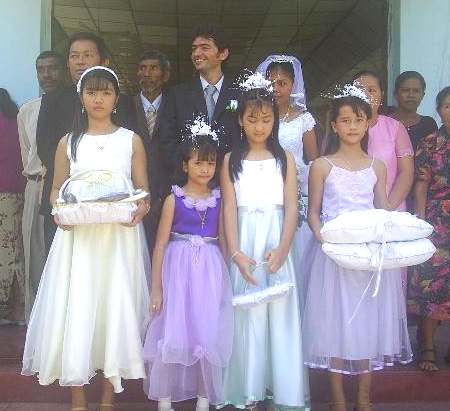|
WEDDING RECEPTIONS
|
|
|
A wedding reception is a party held after the completion of a marriage ceremony. Some sort of post-marriage party is traditional in most societies around the world, but with considerable variety on the details.
Western society
Meal
Most receptions feature a meal. The meal is traditionally either a plated dinner or buffet dinner. Some couples instead elect to host a hors d’œuvre reception or a dessert reception.
Toasts
In most Western countries, before or after a meal (traditionally paid for by the bride's family), toasts are made by offered of the wedding party wishing the couple well in the future. Traditionally, the speaking parties include the bride's father and the groom. In the modern U.S., speeches are more often given by the best man (who usually slips in a few good-natured jokes at the couple's expense) and the maid of honor.
Wedding reception, Hakka people in a wedding in East Timor 2006
Dances
After the speeches, the bride and groom begin their first dance, which used to be called the "bridal waltz"; in most contemporary weddings a recent romantic song is played (common choices include songs by Frank Sinatra, Tony Bennett, Etta James, Dean Martin, and other standards singers) and the bride and groom's dance is rarely an actual waltz. Different dance styles are now used, depending on the nature of the song.
The wedding reception dance party may involve a certain sequence of special dances. For example, after the first dance, the groom may escort his bride to her father for a special father/daughter dance.
Following the various special dances, the guests are invited to join in the dancing. The party continues with toasts and various celebrations until the bride and groom leave in a car decorated by the couple's friends.
A recent trend is the addition of a DVD slideshow or photo montage video featuring pictures of the bride and groom growing up and, eventually meeting. These are created using home movies and photos taken over the couple's life, and edited and set to music using professional video editing software. The montage is shown either on a large TV or monitor, or an LCD projector so all of the guests can enjoy it.
Other traditions
Wedding traditions vary considerably between countries, and even between regions of the same countries. Some traditions include:
Chinese society
In Chinese society, the wedding reception is known as x-ju (literally joyful wine), and is far more important than the wedding itself which tends to be a brief civil ceremony. The timing and the characteristics of the reception vary strongly from locale to locale. They are typically extremely elaborate and expensive, often costing several years' salary of the groom's family. However, because cash in the form of red envelopes and jewelry (particularly gold) are given as wedding presents, and because the wedding hosts keep very careful track of the cost of the gifts (jewelry is given with a receipt which indicates the actual cost of the gift), the cost of the reception is effectively split among the wedding guests. Wedding receptions also build local community solidarity. As each couple weds, their wedding reception is in effect financed with gifts from the other members of the community with the expectation that the new couple and their family will give gifts in future wedding receptions within the village.
LINKS and REFERENCE
|
|
|
This website is Copyright © 2013 Kismet Girls Trust. All rights reserved. All other trademarks are hereby acknowledged. |
